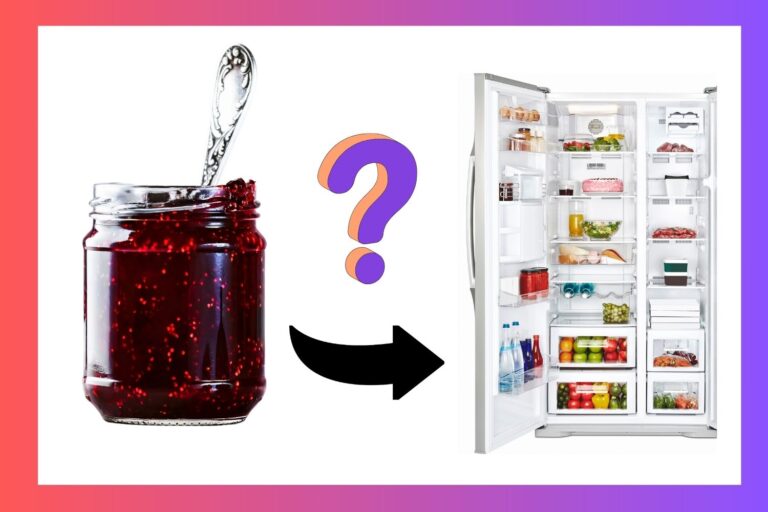Jelly is sweet, fruity, and peanut butter’s best buddy. But here’s the million-dollar question: Does jelly need to be refrigerated?
The answer isn’t as simple as you might think. Some jellies thrive in the pantry, while others demand a chilly home in the fridge.
In this guide, we’ll cover what the science says, and give you expert advice along with storage hacks so you can keep your jelly fresh and delicious.
Does Jelly Need to Be Refrigerated?
The short answer: Yes! You should refrigerate jelly. Here’s why:
Room Temperature vs. Refrigeration: What Experts Say
1. USDA’s Take on Jelly Storage
According to the United States Department of Agriculture (USDA), opened jelly should be refrigerated to maintain quality and prevent microbial growth.
High-sugar jellies can last longer at room temperature, but low-sugar or sugar-free varieties are more prone to spoilage.
2. Food Scientists Weigh In
Experts from the National Center for Home Food Preservation recommend that you refrigerate jelly after opening to slow down bacterial growth and preserve texture.
While sugar acts as a natural preservative, refrigeration prevents mold formation and extends shelf life. Read their guidelines.
3. University Research on Jelly Preservation
Studies from Michigan State University Extension highlight that homemade jelly lacks commercial preservatives, which means refrigeration is essential for safety.
Canned jelly, however, can remain stable at room temperature until opened. Check out their research.
How Long Does Jelly Last? Shelf Life Breakdown.
| Type of Jelly | Room Temperature | Refrigerated |
|---|---|---|
| Unopened Commercial Jelly | 6-12 months | 1-2 years |
| Opened Commercial Jelly | 1-2 weeks | 6 months |
| Homemade Jelly (Unsealed) | 1-2 weeks | 1 month |
| Homemade Jelly (Properly Canned) | 6-12 months | 1-2 years |
Key Takeaway: Refrigeration significantly extends jelly’s shelf life, especially if it’s low-sugar or homemade.
Signs Your Jelly Has Gone Bad (And Why You Shouldn’t Risk It)
Here’s how to know if your jelly has gone bad before it ruins your breakfast:
Mold Growth: If you see fuzzy spots, toss it. Mold spores spread fast!
Sour Smell: Jelly should smell fruity, not funky. If it stinks, get rid of it.
Texture Change: Watery or clumpy jelly? Bacteria might be partying inside.
Discoloration: Darkening or weird color shifts? Time to say goodbye.
If you notice any of these signs, be sure to throw away your jelly immediately.
Don’t just scrape off the mold, it’s not worth the risk.
How to Store Jelly Like a Pro
Want to keep your jelly fresh for as long as possible?
Follow these expert-approved storage tips:
- Keep unopened jelly in a cool, dry place (pantry or cupboard).
- Refrigerate opened jelly to prevent spoilage.
- Use clean utensils to avoid contamination.
- Seal the lid tightly after each use.
- Avoid direct sunlight and humidity, which can degrade quality.
If you’re making homemade jelly, proper canning techniques are key to long-term preservation.
Learn more from the National Center for Home Food Preservation.
Kitchen Tip: Check these other ultimate guides if you’re wondering how to store other pantry staples like BBQ Sauce, ketchup, molasses, peanut butter, honey and mustard.
Frequently Asked Questions (Because We Know You’re Curious)
Can You Store Jelly at Room Temperature?
Yes, unopened jelly can be stored at room temperature. However, once opened, it’s recommended you refrigerate it to prevent mold and bacterial growth.
Does Sugar-Free Jelly Need Refrigeration?
Yes! Sugar-free jelly lacks natural preservatives, making it more prone to spoilage. But refrigeration is essential for maintaining freshness.
Can You Eat Expired Jelly?
If unopened, jelly past its best by date may still be safe if there are no signs of spoilage. Always throw away jelly you’ve already opened if it’s expired.
Is Homemade Jelly Safe Without Refrigeration?
Only properly canned homemade jelly can be stored at room temperature. Otherwise, refrigeration is necessary to prevent bacterial growth.
Final Verdict: Should You Refrigerate Jelly?
While commercial jelly will last at room temperature, refrigerating it is the best way to go to extend its shelf life and prevent spoilage.
You should always refrigerate low-sugar, sugar-free, and homemade jellies to keep them safe to eat and preserve their fresh flavor. Following proper storage practices ensures your jelly stays fresh, flavorful, and safe to eat.
For more expert-backed food storage tips, visit the USDA Food Safety and Inspection Service.
Further Reading
Should Mustard Be Refrigerated?
Does Soy Sauce Be Refrigerated?
Should Honey Be Refrigerated?
Does Fish Sauce Need to Be Refrigerated?
Should Worcestershire Sauce Be Refrigerated?
Better Living uses affiliate links. If you make a purchase through them, we may receive a small commission (for which we are deeply grateful) at no cost to you.



